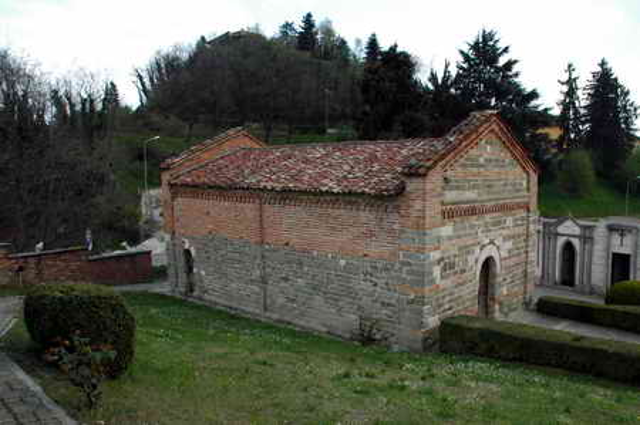Church of St. Peter of Fenestrella (chiesa di San Pietro di Fenestrella)
Highlights
The church has very ancient origins (presumed to date back to the year 1000).
It was a parish church until the 16th century.
The church is called St. Pietro di Fenestrella maybe because of the presence of the three small windows in the apse.
According to Bosio, instead, it was so named because it is located near the narrow gorge between the two hills, almost forming a window towards Aramengo.
The first record of it is contained in a deed of 1235, by which the bishop of Vercelli gives it to the canonical of Vezzolano to be officiated by it, with the obligation to present the holder to Pino's parson, to take to the synod and offer five pounds of wax to the bishop of Vercelli on the day of St. George.
It is the oldest church in Albugnano, probably built before the year 1000 because it's all in sandstone; it was the parish church until the 16th century.
Given that it did not come to us in its primitive form, the church is 5 × 15 meters.
The triumphal arch, in symmetrical layers of terracotta and stone, is no longer the original and develops greatly above a curb or shoulder, re-entering 0.20 meters. Against this arch rests, in its original form, the apse of 2 meters in radius and narrow again of 0.20 meters.
Externally, it is divided by three little columns in three fields, each decorated with a multi-centered window, at the center, of 0.80 × 0.12 m.
The capitals are cubic and rough and the frame, with a big overhang and geometric designs, is supported by developed arches with roughly decorated shelves. Internally, no decoration; the cover of the aisle is on a wooden partition.
The external sidewalls, with a simple base, are divided by two small pilasters pushing up to the frame. It did not come entire to us, except in his apse.
Indeed, the façade was rebuilt in 1870, with shortening at the same time the church of 5 meters, i.e., of one span, and while the primitive was all in sandstone today instead half of the upper part of the side walls, the arches, and the masonry on the major arch are made of small bricks, placed not always with skill, although curled.
The windows and the louver are coeval with the walls, but the stone arches above, part of the frame, and the pediments belong to the primitive material.
The upper part in terracotta was rebuilt around 1690. In fact, the visits from 1577 to 1619 describe it is in a bad state and those of 1637, 1648, 1664 do not mention it because it was no longer officiated. Moreover, in February 1657, the mayors refused to swear in the hands of the vicar of Vezzolano because the abbey refused to restore St. Peter's.
In 1676, the community protested to the Bishop because “the modern Abbot Doria, on the occasion of possession, has entered the church of St. James, the new parish church, while St. Peter falls, and it's not possible to celebrate there”, and pleading to quote the vicar. Again, in the visit of 1681, the mayors complained to the bishop and made a petition for the abbot to invite him to renounce or repair it, to make sure that the celebration can be held.
The petition took effect; the abbot preferred to restore the church instead of giving up the assignment. Meanwhile, taking advantage of the opportunity, the Municipality made the grave for the poor in the church, Giacomo Serra the family tumulus and the abbot, as from the visit dated back to 1732, supplied the church with the necessary for the celebration of the Mass and a picture of the Holy Family as an icon.
We find, in fact, a note, dated June 22, 1711, of 276 lire for the furnishings of St. Peter, on behalf of Vezzolano. In all the subsequent reductions to the Doria it was also made an inventory of St. Peter, where it can be noted: a chalice, a gown, a counter-piece, two mantles, two tunicelle, two black planets with a cope and four candlesticks.
Now the floor is raised, the side door and two windows in rupture are still rear, that is: of that, we read for the first time in 1748 and of these in 1764.
An altar, in terracotta, was blessed in 1794.
The apse, ruined since so long as can be deduced from a photograph of 1910, had an important restoration in 1961.
In 1966, the new altar was built.
Insights
Comune di Albugnano
https://www.comune.albugnano.at.it
- Chiesa di San Pietro
https://www.comune.albugnano.at.it/it/page/chiesa-di-san-pietro-54b84ef9-53ab-40de-83fd-a2810467ed6e
Associazione InCollina, Turismo nel cuore del Piemonte
https://www.turismoincollina.it
- San Pietro, Albugnano
https://www.turismoincollina.it/scopri/chiese-romaniche-tra-po-e-monferrato/san-pietro-albugnano/
GAL BMA - Gruppo di Azione Locale del Basso Monferrato Astigiano
https://www.monferratoastigiano.it/
- Comune di Albugnano (AT)
https://www.monferratoastigiano.it/comune-di-albugnano-at/
See also
News from Albugnano
- Discover the latest news posted on the website of the Municipality of Albugnano
https://www.comune.albugnano.at.it/it/news
Events in Albugnano
- Discover the events posted on the website of the Municipality of Albugnano
https://www.comune.albugnano.at.it/it/events

